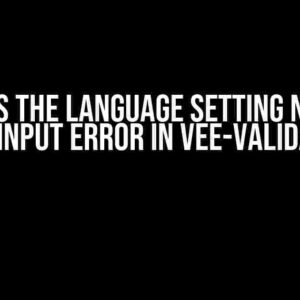As developers, we’ve all been there – staring at a seemingly innocent-looking piece of code, wondering why the verifier is convinced that it’s harboring an infinite loop. But fear not, dear reader, for today we’re going to dive into the depths of this conundrum and emerge with a better understanding of what’s really going on.
The Code in Question
public boolean hasLoop(Node head) {
Node slow = head;
Node fast = head;
while (fast != null && fast.next != null) {
slow = slow.next;
fast = fast.next.next;
if (slow == fast) {
return true;
}
}
return false;
}
At first glance, this code looks like it’s doing a simple loop detection using the tortoise and hare algorithm. And you’re right, it is! But, as we’ll see, there’s a subtle issue lurking beneath the surface.
The Problem: An Infinite Loop?
So, why does the verifier think this code has an infinite loop? To understand this, let’s break down what the code is doing:
- The function takes a
Nodeobject as an input, which represents the head of a linked list. - The two pointers,
slowandfast, are initialized to the head of the list. - The while loop continues as long as
fastis not null andfast.nextis not null. - Inside the loop,
slowmoves one step at a time, whilefastmoves two steps at a time. - If
slowandfastever meet (i.e.,slow == fast), the function returnstrue, indicating that a loop is present.
So, where’s the infinite loop? Well, the verifier is being a bit too cautious, but for good reason. You see, there’s a subtle assumption being made in this code that might not always hold true.
The Assumption: A Linked List with a Finite Number of Nodes
The code assumes that the input linked list has a finite number of nodes. But what if that’s not the case? What if the list has a cycle, and fast can keep moving indefinitely?
Consider the following scenario:
| Node | Next Node |
|---|---|
| A | B |
| B | C |
| C | D |
| D | A |
In this example, we have a linked list with a cycle (A -> B -> C -> D -> A). If we run the code with this input, fast will keep moving indefinitely, never reaching the end of the list. And that’s where the infinite loop comes in.
The Solution: Adding a Safety Net
So, how do we fix this issue? Simple: we add a safety net to ensure that our code doesn’t get stuck in an infinite loop. We can do this by keeping track of the number of iterations and setting a maximum limit.
public boolean hasLoop(Node head) {
Node slow = head;
Node fast = head;
int iterations = 0;
while (fast != null && fast.next != null) {
slow = slow.next;
fast = fast.next.next;
iterations++;
if (iterations > MAX_ITERATIONS) {
throw new RuntimeException("Infinite loop detected");
}
if (slow == fast) {
return true;
}
}
return false;
}
In this updated code, we’ve added a variable iterations to keep track of the number of times we’ve iterated through the loop. If the number of iterations exceeds a certain threshold (MAX_ITERATIONS), we throw an exception to indicate that an infinite loop has been detected.
Conclusion
And there you have it, folks! We’ve successfully navigated the treacherous waters of infinite loops and emerged with a deeper understanding of the importance of assumptions in coding. Remember, always be mindful of the assumptions you make in your code, and don’t be afraid to add a safety net to prevent those pesky infinite loops.
So, the next time the verifier warns you about an infinite loop, take a step back, and ask yourself: “What assumption am I making that might not always be true?”
Frequently Asked Question
Are you stuck in a loop and can’t seem to figure out why? Don’t worry, we’ve got you covered! Here are some frequently asked questions about why the verifier detects an infinite loop in your code.
What is an infinite loop, and why is it a problem?
An infinite loop is a sequence of instructions that continues to execute indefinitely. It’s a problem because it can cause your program to consume all available memory and CPU resources, leading to a crash or freeze. In some cases, it can even lead to data loss or corruption!
Why does the verifier detect an infinite loop in my code?
The verifier detects an infinite loop in your code because it’s designed to identify potential issues that could cause your program to malfunction. It analyzes your code and flags any sections that could lead to infinite execution. This is usually due to a logic error or a missing termination condition in your loop.
How do I fix an infinite loop in my code?
To fix an infinite loop, you need to identify the cause and add a termination condition to your loop. This could be a counter, a boolean flag, or a conditional statement that breaks the loop when a certain condition is met. Make sure to test your code thoroughly to ensure the loop terminates correctly.
Can I use a timer to detect infinite loops?
While a timer can help detect infinite loops, it’s not a foolproof solution. A timer may not always catch an infinite loop, especially if it’s a subtle issue. It’s better to write robust code with proper termination conditions rather than relying on a timer to detect errors.
What are some best practices to avoid infinite loops in my code?
To avoid infinite loops, make sure to always include a termination condition in your loops, use debugging tools to test your code, and consider using recursive functions instead of loops when possible. Additionally, code reviews and testing can help catch infinite loops early on in the development process.



